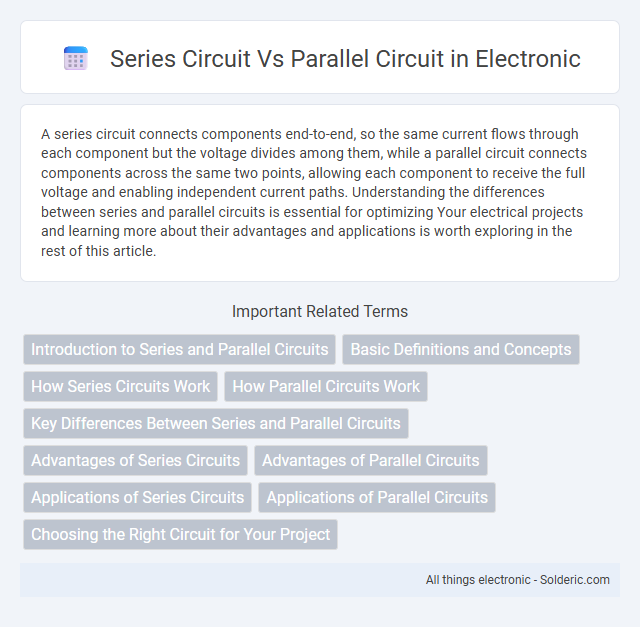A series circuit connects components end-to-end, so the same current flows through each component but the voltage divides among them, while a parallel circuit connects components across the same two points, allowing each component to receive the full voltage and enabling independent current paths. Understanding the differences between series and parallel circuits is essential for optimizing Your electrical projects and learning more about their advantages and applications is worth exploring in the rest of this article.
Comparison Table
| Aspect | Series Circuit | Parallel Circuit |
|---|---|---|
| Current | Same through all components | Divides among branches |
| Voltage | Divides across components | Same across all branches |
| Total Resistance | Sum of all resistances (R_total = R1 + R2 + ...) | Reciprocal of sum of reciprocals (1/R_total = 1/R1 + 1/R2 + ...) |
| Effect of Component Failure | Entire circuit stops working | Other branches continue functioning |
| Application | Simple circuits, e.g. holiday lights | Home wiring, electronic devices |
| Power Distribution | Power varies with resistance in each component | Power supplied independently to each branch |
Introduction to Series and Parallel Circuits
Series circuits connect components end-to-end, creating a single path for current flow, where the total resistance equals the sum of individual resistances and voltage divides across components. Parallel circuits have multiple branches, each providing an independent path for current, maintaining the same voltage across all components while the total current is the sum of branch currents. Understanding how series and parallel circuits influence current, voltage, and resistance helps you design efficient electrical systems tailored to specific needs.
Basic Definitions and Concepts
A series circuit features components connected end-to-end, allowing current to flow through a single path, while a parallel circuit has multiple branches, providing separate paths for current flow. In a series circuit, the total resistance is the sum of individual resistances, causing the current to be the same through all components; in contrast, a parallel circuit has a total resistance that is less than any individual resistance, and voltage across each branch remains constant. Understanding these basic concepts helps you design electrical systems with desired current and voltage characteristics.
How Series Circuits Work
Series circuits work by connecting electrical components end-to-end, creating a single path for current flow. The current remains constant throughout the circuit, while the total voltage is the sum of the individual voltage drops across each component. Resistance in a series circuit adds up, affecting the overall current according to Ohm's Law.
How Parallel Circuits Work
Parallel circuits distribute electrical current through multiple paths, allowing each component to operate independently. The voltage across each branch remains equal to the source voltage, ensuring consistent power delivery to your devices. This design improves reliability, as a failure in one branch does not interrupt the entire circuit's operation.
Key Differences Between Series and Parallel Circuits
Series circuits feature components connected end-to-end, resulting in a single path for electric current, so if one component fails, the entire circuit stops working. Parallel circuits have multiple branches, providing independent paths for current, which means your devices can operate separately without affecting each other. Voltage distribution in series circuits is divided among components, while in parallel circuits, each branch receives the full source voltage, affecting efficiency and performance.
Advantages of Series Circuits
Series circuits offer the advantage of simplicity in design and ease of installation, making them ideal for basic electrical applications. They provide consistent current flow through each component, ensuring uniform operation and straightforward troubleshooting. The lower wiring complexity reduces material costs and enhances circuit reliability in low-power systems.
Advantages of Parallel Circuits
Parallel circuits offer significant advantages, including consistent voltage across all components and superior reliability since a failure in one branch does not disrupt the entire circuit. This configuration allows each device to operate independently, enhancing overall system efficiency and flexibility. Your electronic setup benefits from easier troubleshooting and the ability to add or remove devices without affecting the rest of the circuit.
Applications of Series Circuits
Series circuits are commonly used in applications where the same current must flow through all components, such as in Christmas lights and old-style string lights, ensuring uniform brightness across bulbs. Their simple design makes series circuits ideal for devices like fuse systems, where a break in the circuit immediately stops the flow of electricity, providing safety. Understanding the use of series circuits helps you choose the right configuration for situations requiring consistent current and straightforward troubleshooting.
Applications of Parallel Circuits
Parallel circuits are widely used in household electrical systems because they allow multiple devices to operate independently without affecting each other's performance. In automotive wiring, parallel circuits ensure that if one component fails, the others can continue functioning, enhancing vehicle safety. Your electronics also benefit from parallel configurations, as they provide consistent voltage across all components, improving overall device reliability.
Choosing the Right Circuit for Your Project
When choosing the right circuit for your project, consider that series circuits offer simplicity and consistent current flow but depend on each component functioning properly to maintain the circuit. Parallel circuits provide independent paths for each device, ensuring that if one component fails, the others continue to operate, which is ideal for complex or multi-device projects. Your decision should balance the need for reliability, voltage distribution, and ease of troubleshooting in the overall circuit design.
series circuit vs parallel circuit Infographic

 solderic.com
solderic.com